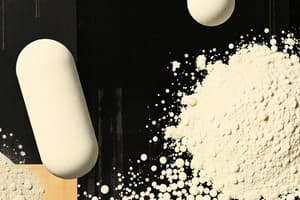Podcast
Questions and Answers
Which of the following is NOT true about powders in pharmaceutical formulations?
Which of the following is NOT true about powders in pharmaceutical formulations?
- The properties of powders are related to the size and surface area of the particles
- Properly prepared powders have a uniform, small particle size
- Powders are more stable than liquid dosage forms
- Topical powders should have a large particle size that will not irritate the skin (correct)
What is the purpose of characterizing solid materials before using them in pharmaceutical products?
What is the purpose of characterizing solid materials before using them in pharmaceutical products?
- To increase the bioavailability of the materials
- To determine the chemical and physical features of the materials (correct)
- To reduce the particle size of the materials
- To sterilize the materials
What is the particle size range of fine dispersions according to the text?
What is the particle size range of fine dispersions according to the text?
- 0.5 to 5 μm
- 1 to 10 μm
- 1 to 5 μm (correct)
- 5 to 10 μm
Flashcards are hidden until you start studying
Study Notes
Overview of Powders in Pharmaceutical Formulations
- Powders are solid or mixture of solids reduced to a finely divided state intended for internal or external use.
- Properly prepared powders have a uniform, small particle size that has an elegant appearance and are more stable than liquid dosage forms.
- The properties of powders are related to the size and surface area of the particles, which must be considered in mixing, storing, and shipping.
- Topical powders should have a uniform, small particle size that will not irritate the skin when applied and should adhere to the skin.
- Highly sorptive powders should not be used for topical powders that are to be applied to oozing wounds.
- Insufflated powders are finely divided powders that are intended to be applied in a body cavity, such as the ears, nose, vagina, tooth socket, or throat.
- Before using powders in the preparation of pharmaceutical products, solid materials are characterized to determine their chemical and physical features.
- The particle size of a given powder is characterized by the United States Pharmacopeia (USP) using descriptive terms such as very coarse, coarse, moderately coarse, fine, and very fine.
- Drug micronization can increase the rate of drug dissolution and its bioavailability.
- Fine dispersions have particles ~0.5 to 10 μm, and particles intended to be inhaled for deposition deep in the respiratory tract are ~1 to 5 μm.
- A lack of grittiness of solid particles is essential in dermal ointments, creams, and ophthalmic preparations.
- Powders should be dispensed in tight containers to prevent exposure to atmospheric conditions, and talc or any other naturally derived product that is to be used on open wounds should first be sterilized to avoid infection.
Studying That Suits You
Use AI to generate personalized quizzes and flashcards to suit your learning preferences.




